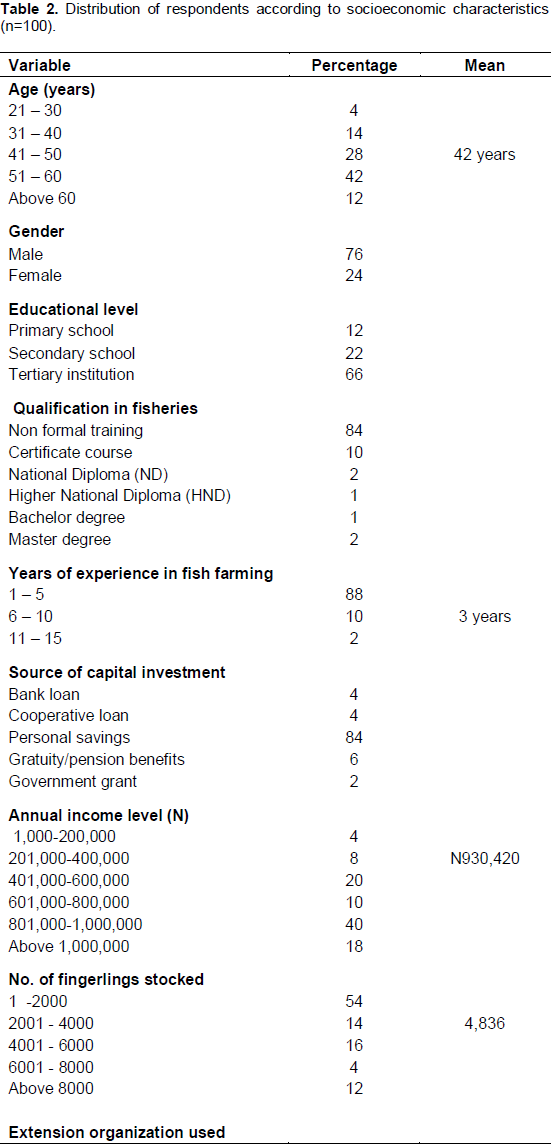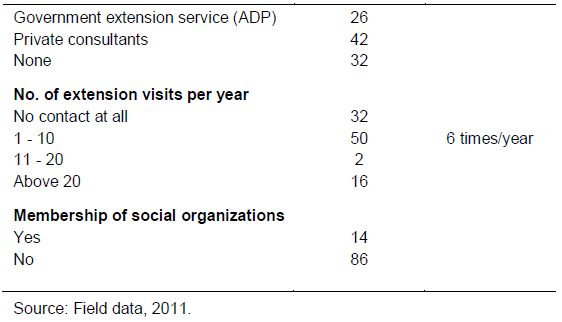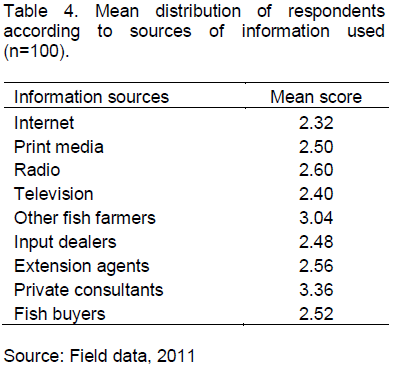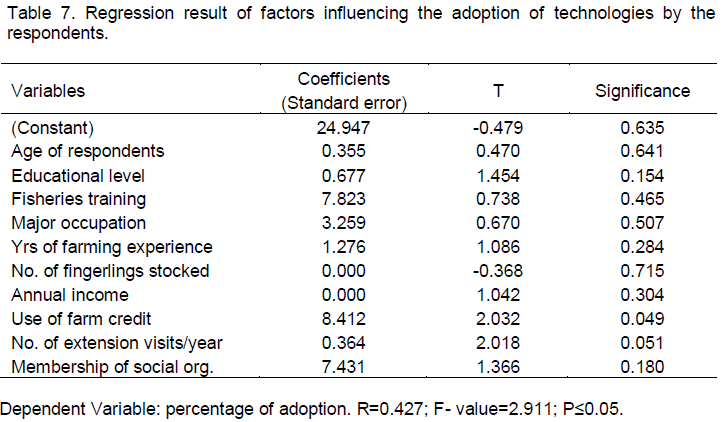ABSTRACT
A survey was conducted in the Southern Agricultural zone of Nasarawa State, north central Nigeria, to assess the intensity of adoption of improved fisheries technologies among fish farmers. A sample of 100 fish farms out of the 202 existing farms identified during the survey was randomly selected for the study. A structured interview schedule was administered to the managers of the selected fish farms to elicit information. Both descriptive and inferential statistics were used to analyze the data. The results show that the rate of adoption of selected improved technologies among fish farmers in the study area was high (53.04%), with five of the technologies topping the adoption index. These were the use of improved fingerlings (94%) adoption rate (94%), floating feeds (92%), inlet/outlet devices (90%), daily sanitary practices and record-keeping (82%). Most of the respondents were small-scale producers with a mean stocking rate of 4,834 fingerlings. Private fisheries consultants were the major sources of information used by the respondents. The major recommendations to ensure increased fish production by the respondents include: Fish farmers should form cooperative groups in order to gain easy access to credit; special training in on-farm feed formulation should be organized for fish farmers; and government should provide storage and processing facilities for fish farmers as well as improved electricity supply to enhance production.
Key words: Adoption, improved fisheries technologies, fish farmers, Nasarawa State, Nigeria.
In Nigeria, the role of fish farming in achieving household and national food security and poverty alleviation cannot be over emphasized. Fish farming, an artificial method of raising fish for human consumption, is an ancient practice that can still provide profitable means of livelihood for both rural and urban dwellers. Fish farming is the principal form of aquaculture. It involves raising fish commercially in tanks or enclosures, usually for food. Fish is a popular source of protein and white meat in almost all parts of Nigeria. Fish is very nutritious, providing a good source of high-quality protein and other essential nutrients, which are especially important for mothers and growing children. It is low in calories and cholesterol levels, but rich in protein (FAO, 2005).
According to the Central Bank of Nigeria (CBN, 2005), fisheries occupy an important position in the agricultural sector of the Nigerian economy. The contribution of the fisheries sub-sector to GDP rose from N76.76 billion in 2001 to N162.61 billion in 2005 (CBN, 2005). However, the gap between supply and demand for fish in Nigeria is widening. Almost all natural fish stocks in the country have been over-exploited, yet human populations, and hence demand, continue to increase. According to Dauda (2010), national fish demand in Nigeria is 1.85 million metric tons while domestic production is about 0.51 million metric tons. Nigeria currently imports about 0.7 million metric tons of frozen fish annually, making it the highest importer of frozen fish in the world, at an annual foreign exchange cost of N35 billion.
Access to accurate and adequate information on fish production technologies by farmers is essential for increased fish production. Such information must come from credible sources, at the right time, and the farmers should be able to utilize (adopt) them correctly. Information on fish farming technologies needed by farmers cover a wide range of areas, such as pond construction and management, breed selection, stocking, feeding, water management, spawning, sorting, harvesting, processing, storage, marketing and record-keeping (Ofuoku et al., 2008). The technologies used by most Nigerian fish farmers are relatively simple, often based on small modifications that improve the growth and survival rates of the target species, e.g. improving food, seeds, oxygen levels and protection from predators.
Nasarawa State in central Nigeria has great fisheries potentials. The Southern Agricultural zone of the State is blessed with so many, streams and ponds that can be harnessed for fish farming. In spite of this great potential, fish farming in Nigeria, especially in Nasarawa state, is still poorly developed, forcing the country to rely on fish importation to meet the rising local demand. According to Amali and Solomon (2001), some of the constraints to increased fish production in Nigeria include inadequate fingerling production, lack of earth-moving equipment, the high cost of fish feeds, low capital investment, and the non-adoption of improved production and processing technologies by most fish farmers.
The Nasarawa Agricultural Development Programme (NADP) has taken some positive steps in this direction by introducing some modern technologies to fish farmers in the state since 2002. These include:
1. Improved techniques in pond construction and maintenance.
2. Introduction of modern fish hatchery equipment.
3. Provision of inlet and outlet devices in ponds.
4. Introduction of improved fish species for optimum yield.
5. Aerated containers for transporting fingerings to reduce stress and mortality
6. Construction of modern fishing gears.
7. Techniques of improving water quality in fish culture.
8. Fortification of fish feeds using root and tuber crops.
9. Fertilization and liming of fish ponds.
10. Fish preservation and storage techniques
11. Prevention and control of fish diseases.
12. Control of predators in fish ponds.
13. Techniques of hatchery and fingerlings production
14. Integrated fish farming for increased fish production.
15. Construction and use of modern klins for improved fish smoking.
However, it is not known to what extent these technologies have been adopted by fish farmers in the state, and what constraints they are facing in adopting the improved technologies. The purpose of this study was to assess the intensity of adoption of improved technologies by fish farmers in the Southern Agricultural zone of Nasarawa state. The specific objectives were to:
1. Describe the socio-economic characteristics of fish farmers in the area;
2. Identify the sources of fisheries information mostly used by the respondents;
3. Determine the intensity of adoption of improved fisheries technologies by the respondents;
4. Identify the production constraints facing fish farmers in the area; and,
5. Determine the effects of respondents’ socioeconomic characteristics on their level of adoption of improved technologies.
This study was conducted in the Southern Agricultural zone of Nasarawa state, north central Nigeria. Nasarawa state is located between latitudes 7° and 9°N and longitudes 7° and 10°E. It shares boundaries with Benue state to the south, Kogi state to the west, the Federal Capital Territory (FCT) to the north-west; Kaduna and Plateau states to the north-east, and Taraba state in the south-east. Agriculture is the dominant occupation of the inhabitants of Nasarawa state. The southern agricultural zone covers five Local government areas (LGAs) namely: Awe, Doma, Keana, Lafia and Obi.
A multi-stage sampling procedure was adopted in this study. First, 3 out of the 5 LGAs in the southern agricultural zone of the state were purposively selected based on their popularity in fish farming. These were Lafia, Doma and Obi LGAs. A preliminary survey conducted across the 3 selected LGAs showed the existence of about 202 fish farms in the selected LGAs. In the second stage, about 50% of the identified fish farms in each of the 3 LGAs were selected. This gave a total of 100 fish farms selected for the survey (Table 1), with the farm managers as the respondents. Primary data were collected with the aid of a structured interview schedule administered on the respondents between May and July 2011.
Data analysis
Data collected were analyzed using SPSS computer packages. Both descriptive and inferential statistics were used in the analysis.
Simple descriptive statistics such as frequency mean and percentage were used to realize objectives (1), (2) and (3). Mean scores was used to realize objective (4) while a multiple regression model was used to achieve objective (5). The model is represented thus:
Y = f(X1,X2,X3,X4,X5,X6,X7,X8,X9,X10, µ ) where
Y = Adoption rate
X1 = Age of respondent (in years)
X2 = Level of education (in years)
X3 = Formal training in fisheries (qualification obtained)
X4 = Major occupation (farming, trading, civil service, artisan or politician)
X5 = Experience in fish farming (in years)
X6 = Farm size (no. of fingerlings stocked)
X7 = Annual income (in naira)
X8 = Use of credit (total amount received in previous 5 years)
X9= Number of extension visits per year
X10 = No. of cooperative/social organizations belonged
Socio-economic characteristics of the respondents
Table 2 shows the percentage and mean distribution of the respondents’ socioeconomic characteristics. The mean age of the respondents was 42 years. This shows that most of the fish farmers in the study area were middle-aged. Age is usually considered to be a primary latent characteristic in adoption decisions (Agbamu, 2006). The majority (76%) of the respondents were males while 24% were females. Most (66%) had acquired tertiary education. It is widely believed that education creates a favourable mental attitude for the acceptance of new ideas and practices. It enables a farmer to seek for and utilize useful information from both print and electronic media, thereby accelerating the rate of adoption of technologies (Ozor and Madukwe, 2005; Agbamu, 2006). The majority (84%) of the respondents did not receive any formal training in fish farming before going into the enterprise.


Table 2 also shows that majority (88%) of the fish farmers had 1 to 5 years’ experience in fish farming, with a mean of 3 years. This implies that fish farming was at its infant stage in the study area, with most farmers having very little experience. This could mean that the farmers lacked relevant skills in management of fish farms. Experience is important for effective day-to-day running of farm enterprise and could influence positively the adoption of innovations (Adebiyi, 2008). The majority (84%) of the respondents used personal savings as capital for fish farming. This shows that most of the respondents did not have access to credit for investment in the enterprise. This finding agrees with that of (Adebiyi, 2008) who observed that majority of cocoa farmers in Oyo state of Nigeria sourced their capital from personal savings. However, the mean annual gross income of the respondents was N930,420. This implies that fish farming was a profitable enterprise which provided self-employment for people in the area. High income levels have been found to positively influence the adoption of agricultural technologies (Agwu, 2004; Agbamu, 2006)
The mean farm size (stocking rate) of the respondents was 4,836 fingerlings, which implies that most of the respondents were small-scale fish farmers. This finding agrees with those of Nnaji et al. (2003) and Ayinla (2003), who observed that fish farming in Nigeria was mainly at a subsistence level and that small-scale producers find it difficult to adopt technologies that are capital-intensive. A greater proportion (42%) of the respondents patronized private consultants to get technical information on fish farming, and 26% used government extension agents from the state ADP, while 32% relied on other farmers. The mean number of extension visits received per year was 6. This finding is similar to that of Ofuoku et al. (2008), who observed that the majority (70%) of fish farmers in Central agricultural zone of Delta State, Nigeria relied on NGOs and farmers’ associations for information on fish farming.
The majority (86%) of the respondents did not belong to any farmers’ organization. This implies that fish farmers in the area had not organized themselves into associations/cooperatives. Membership of social groups accelerates the adoption of improved technologies (Wabbi, 2002).
Fish production systems by the respondents
Table 3 shows that the majority (78%) of the respondents used (relatively expensive) concrete ponds, 14% used earthen ponds and 8% used tanks/basins. This finding agrees with that of Nwachukwu and Onuegbu (2005) who observed that most fish farmers in Nigeria operated small- scale farms ranging from homestead concrete ponds to small earthen ponds. Most (52%) of the respondents used boreholes as a source of water to their fish ponds, 26% used streams/rivers, and 22% used deep wells. Although drilling a borehole can be too expensive for small-scale producers, water from such a source is less polluted than the one from streams. The majority (78%) of the respondents got their fingerlings from commercial hatcheries.
Sources of information used by the respondents
Table 4 shows the mean distribution of respondents according to the sources of information most frequently used. Two information sources were most frequently used by the respondents: private consultants (M=3.36), followed by other fish farmers (M=3.04). This implies that most of the farmers patronized conventional sources of information rather than the electronic sources such as internet, mobile phones, computer, online magazine, etc. The very low patronage of the internet as a source of fish farming information might be due to the low level of computer literacy among the fish farmers. This finding is similar to that of Ofuoku et al. (2008) who reported that the majority (70%) of the fish farmers in Delta State, Nigeria, got their information on fish farming practices from other farmers and private consultants. According to Agbamu (2006), the sources of information mostly used by farmers in developing countries are influenced by the farmer’s age level of education, available sources of innovations, and the extent of modernization in the locality.

Adoption of improved fisheries technologies by the respondents
Table 5 shows the percentage distribution of respondents according to their intensity of adoption of various fisheries technologies disseminated by the Nasarawa Agricultural Development Programme (NADP). Use of improved breeds ranks first, with a 94% adoption rate, and floating feeds second (92%), while the use of inlet/outlet devices ranks 3rd (90%). Daily sanitary practices and record keeping rank 4th with an adoption rate of 82%. The overall mean adoption index is 54.04%, with 14 out of the 23 technologies disseminated having an adoption level over 50%, implying a high level of adoption of most of the improved technologies among the respondents. According to Bolorundoru and Adesehenwa (2004), the adoption of fisheries technologies by small-scale farmers depends on cost, availability of recommended inputs, and ease of handling.
Constraints to increased fish production by the respondents
Table 6 shows the mean distribution of the respondents according to constraints faced. Only four factors out of the 17 presented were rated as serious constraints facing fish farming in the study area. These were: The high cost of feeds (M = 2.62), inadequate capital (M = 2.38), poor storage and processing facilities (M = 2.16), and the high cost of fingerlings (M = 2.12).
Effect of respondents’ socioeconomic characteristics on adoption of improved technologies
The regression results in Table 7 show that there were statistically significant effects (F=2.911 overall) at P≤0.05 of the selected socioeconomic variables on the rate of adoption of improved technologies by the respondents.

The R-squared value (R2 =0.427) shows that about 43% of the variability in the dependent variable (adoption rate) was due to the effects of farmers’ socioeconomic characteristics (independent variables). It also shows that the use of farm credit (t = 2.032; P<0.049) and number of extension visits per year (t = 2.018; P<0.051) were positively significant. Other factors such as age, educational level, formal training in fisheries, and years of farming experience, income level and number of social organizations belonged showed positive relationships with the rate of adoption but were not significant. However, it was observed that number of fingerlings stocked (pond size) had a negative correlation with adoption rate. This implies that the higher the stocking rate, the lower the adoption rate. Agbamu (2006) and Wabbi (2002) found the use of credit and the number of extension visits per year to have positive and significant effects on adoption rate of integrated pest management (IPM).
The positive significant effect of use of credit and number of extension visits is not a surprise. This is because credit enables a farmer to invest more in farm production and hence to improve his ability to procure improved technologies that will boost yield. Also, frequent extension contacts help to create awareness and educate the farmers on the use of recent technologies leading to higher rates of adoption.
CONCLUSION AND RECOMMENDATIONS
From the above findings it was concluded that the rate of adoption of improved technologies by fish farmers in the study area was high (M=53.04%). Most of the respondents were small –scale producers with a mean stocking rate of 4,834 fingerlings. Private fisheries consultants were the major sources of information used by the respondents. This suggests that fish farmers in the area were paying a fee for extension services. This supports the agitations for the privatization and commercialization of extension services in this sector. Based on the findings of the study, the following policy recommendations were made:
1. Fish farmers in the area should be encouraged and mobilized to form cooperative groups in order to gain easy access to credit.
2. Special training in on-farm feed formulation should be organized for fish farmers to enable them to formulate cheaper fish feeds using locally available feedstuffs.
3. Government should provide storage and processing facilities for fish farmers as well as improved electricity supply to enhance production.
4. Government should provide grants to the state ADP to establish fisheries demonstration farms in strategic locations in the state to train local farmers on modern fish farming.
The authors have not declared any conflict of interest.
REFERENCES
|
Adebiyi S (2008). Factors affecting adoption of cocoa rehabilitation techniques in Oyo State of Nigeria. Unpublished Masters Thesis; Department of Agricultural Economics and Extension, Federal Univer. Technol. Akure. pp. 1-86. |
|
|
|
Agbamu JU (2006). Essentials of agricultural communication in Nigeria. Malthouse Press Ltd. Lagos, Nigeria. pp. 47-73. |
|
|
|
Agwu AE (2004). Factors influencing adoption of improved cowpea production technologies in Nigeria. J. Int. Agric. Extension Education. Spring 2004. 11(1):81-88. |
|
|
|
Amali EI, Solomon SG (2001). Growth and survival of first feeding larvae of Clarias gariepinus fed live and preserved zooplankton. J. Aquat. Sci. 2(1):29-31. |
|
|
|
Ayinla CA (2003). Integrated fish farming: A veritable tool for poverty alleviation/ hunger eradication in the Niger Delta region. In: Eyo, A.A. and Ayanda, J.O. (eds). Conference proceedings of Fisheries society of Nigeria, Oweri, Nigeria pp. 440-441. |
|
|
|
Bolorundoru PI, Adesehenwa AOK (2004). Adoption status of disseminated technologies on the artisanal fisheries of Niger state, Nigeria. Tropical and Subtropical Agro ecosystem 4(1):1-5. Universidad Autonomade Yucatan, Mexico. |
|
|
|
Central Bank of Nigeria (2005). Annual Report and Statement of Accounts. CBN, Abuja. |
|
|
|
FAO (2005). Nutritional benefits of fish cuds. fao.org/docrep/168. Retrieved on 2/02/2011. |
|
|
|
Nnaji CJ, Okoye FC, Ogunseye JO (2003). Integrated fish farming practices with special reference to combination rates production figures and economic evaluation. In: Eyo, A.A., and Ayanda, J.O. (Eds). Conference Proceedings of Fisheries Society of Nigeria (FISON). Oweri, 8th-12th December, 2003. pp. 173-178. |
|
|
|
Nwachukwu I, Onuegbu R (2005). Adoption of aquaculture technology by fish farmers in Imo State of Nigeria. J. Technology Studies, pp. 57-60. |
|
|
|
Ofuoku AN, Emah GN, Itedjere BE (2008). Information utilization among rural fish farmers in central agricultural zone of Delta State, Nigeria. World J. Agric. Sci. 4(5):558–564. |
|
|
|
Ozor N, Madukwe MC (2005). Obstacles to the adoption of improved rabbit technologies by small scale farmers in Nsukka LGA. J. Agric. Food, Environ. Ext. Agro-sci. January 2005. 4(1):70-73. |
|
|
|
Wabbi JB (2002). Assessing the factors affecting adoption of agricultural technologies: The case of integrated pest management (IPM) in Kami district, Eastern Uganda. M.Sc thesis submitted to the Faculty of the Virginia Polytechnic Institute and State University, Blacksburg, Virginia pp. 23-27.
|
Adebiyi S (2008). Factors affecting adoption of cocoa rehabilitation techniques in Oyo State of Nigeria. Unpublished Masters Thesis; Department of Agricultural Economics and Extension, Federal Univer. Technol. Akure. pp. 1-86. |
|
|
|
Agbamu JU (2006). Essentials of agricultural communication in Nigeria. Malthouse Press Ltd. Lagos, Nigeria. pp. 47-73. |
|
|
|
Agwu AE (2004). Factors influencing adoption of improved cowpea production technologies in Nigeria. J. Int. Agric. Extension Education. Spring 2004. 11(1):81-88. |
|
|
|
Amali EI, Solomon SG (2001). Growth and survival of first feeding larvae of Clarias gariepinus fed live and preserved zooplankton. J. Aquat. Sci. 2(1):29-31. |
|
|
|
Ayinla CA (2003). Integrated fish farming: A veritable tool for poverty alleviation/ hunger eradication in the Niger Delta region. In: Eyo, A.A. and Ayanda, J.O. (eds). Conference proceedings of Fisheries society of Nigeria, Oweri, Nigeria pp. 440-441. |
|
|
|
Bolorundoru PI, Adesehenwa AOK (2004). Adoption status of disseminated technologies on the artisanal fisheries of Niger state, Nigeria. Tropical and Subtropical Agro ecosystem 4(1):1-5. Universidad Autonomade Yucatan, Mexico. |
|
|
|
Central Bank of Nigeria (2005). Annual Report and Statement of Accounts. CBN, Abuja. |
|
|
|
FAO (2005). Nutritional benefits of fish cuds. |
|
|
|
Nnaji CJ, Okoye FC, Ogunseye JO (2003). Integrated fish farming practices with special reference to combination rates production figures and economic evaluation. In: Eyo, A.A., and Ayanda, J.O. (Eds). Conference Proceedings of Fisheries Society of Nigeria (FISON). Oweri, 8th-12th December, 2003. pp. 173-178. |
|
|
|
Nwachukwu I, Onuegbu R (2005). Adoption of aquaculture technology by fish farmers in Imo State of Nigeria. J. Technology Studies, pp. 57-60. |
|
|
|
Ofuoku AN, Emah GN, Itedjere BE (2008). Information utilization among rural fish farmers in central agricultural zone of Delta State, Nigeria. World J. Agric. Sci. 4(5):558–564. |
|
|
|
Ozor N, Madukwe MC (2005). Obstacles to the adoption of improved rabbit technologies by small scale farmers in Nsukka LGA. J. Agric. Food, Environ. Ext. Agro-sci. January 2005. 4(1):70-73. |
|
|
|
Wabbi JB (2002). Assessing the factors affecting adoption of agricultural technologies: The case of integrated pest management (IPM) in Kami district, Eastern Uganda. M.Sc thesis submitted to the Faculty of the Virginia Polytechnic Institute and State University, Blacksburg, Virginia pp. 23-27. |
|